Processing α-Chitin into Stable Composite Materials for Heavy Metal Adsorption
Abstract
1. Introduction
2. Results and Discussion
2.1. Characterisation of Composites
2.2. Characterisation of the Adsorbent After Eu Adsorption
3. Materials and Methods
3.1. Chemicals
3.2. Sample Preparation
3.3. Batch Eu(III) Sorption Experiments
3.4. Scanning Electron Microscopy (SEM)
3.5. Fourier Transform Infrared (FTIR) Spectroscopy
3.6. Nuclear Magnetic Resonance (NMR)
3.7. Inductively Coupled Plasma Optical Emission Spectroscopy (ICP-OES)
4. Conclusions
Supplementary Materials
Author Contributions
Funding
Institutional Review Board Statement
Informed Consent Statement
Data Availability Statement
Acknowledgments
Conflicts of Interest
References
- Bruggeman, C.; Maes, N. Uptake of Uranium(VI) by Pyrite under Boom Clay Conditions: Influence of Dissolved Organic Carbon. Environ. Sci. Technol. 2010, 44, 4210–4216. [Google Scholar] [CrossRef] [PubMed]
- Cadogan, E.I.; Lee, C.-H.; Popuri, S.R.; Lin, H.-Y. Efficiencies of Chitosan Nanoparticles and Crab Shell Particles in Europium Uptake from Aqueous Solutions through Biosorption: Synthesis and Characterization. Int. Biodeterior. Biodegrad. 2014, 95, 232–240. [Google Scholar] [CrossRef]
- Hao, Y.; Cui, Y.; Peng, J.; Zhao, N.; Li, S.; Zhai, M. Preparation of Graphene Oxide/Cellulose Composites in Ionic Liquid for Ce (III) Removal. Carbohydr. Polym. 2019, 208, 269–275. [Google Scholar] [CrossRef] [PubMed]
- Li, Y.; Sheng, G.; Sheng, J. Magnetite Decorated Graphene Oxide for the Highly Efficient Immobilization of Eu (III) from Aqueous Solution. J. Mol. Liq. 2014, 199, 474–480. [Google Scholar] [CrossRef]
- Lujanienė, G.; Novikau, R.; Karalevičiūtė, K.; Pakštas, V.; Talaikis, M.; Levinskaitė, L.; Selskienė, A.; Selskis, A.; Mažeika, J.; Jokšas, K. Chitosan-Minerals-Based Composites for Adsorption of Caesium, Cobalt and Europium. J. Hazard. Mater. 2024, 462, 132747. [Google Scholar] [CrossRef] [PubMed]
- Nikiforova, T.; Kozlov, V.; Razgovorov, P.; Politaeva, N.; Velmozhina, K.; Shinkevich, P.; Chelysheva, V. Heavy Metal Ions(II) Sorption by a Cellulose-Based Sorbent Containing Sulfogroups. Polymers 2023, 15, 4212. [Google Scholar] [CrossRef]
- Younes, I.; Rinaudo, M. Chitin and Chitosan Preparation from Marine Sources: Structure, Properties and Applications. Mar. Drugs 2015, 13, 1133–1174. [Google Scholar] [CrossRef]
- Crini, G. Recent Developments in Polysaccharide-Based Materials Used as Adsorbents in Wastewater Treatment. Prog. Polym. Sci. 2005, 30, 38–70. [Google Scholar] [CrossRef]
- Muzzarelli, R.A.A. Potential of Chitin/Chitosan-Bearing Materials for Uranium Recovery: An Interdisciplinary Review. Carbohydr. Polym. 2011, 84, 54–63. [Google Scholar] [CrossRef]
- Rafatullah, M.; Sulaiman, O.; Hashim, R.; Ahmad, A. Adsorption of Methylene Blue on Low-Cost Adsorbents: A Review. J. Hazard. Mater. 2010, 177, 70–80. [Google Scholar] [CrossRef]
- Vo, T.S.; Hossain, M.M.; Jeong, H.M.; Kim, K. Heavy Metal Removal Applications Using Adsorptive Membranes. Nano Converg. 2020, 7, 36. [Google Scholar] [CrossRef] [PubMed]
- Qasem, N.A.A.; Mohammed, R.H.; Lawal, D.U. Removal of Heavy Metal Ions from Wastewater: A Comprehensive and Critical Review. Npj Clean Water 2021, 4, 27. [Google Scholar] [CrossRef]
- Cárdenas, G.; Cabrera, G.; Taboada, E.; Miranda, S.P. Chitin Characterization by SEM, FTIR, XRD, and 13C Cross Polarization/Mass Angle Spinning NMR. J. Appl. Polym. Sci. 2004, 93, 1876–1885. [Google Scholar] [CrossRef]
- Shahidi, F.; Arachchi, J.K.V.; Jeon, Y.-J. Food Applications of Chitin and Chitosans. Trends Food Sci. Technol. 1999, 10, 37–51. [Google Scholar] [CrossRef]
- Brunner, E.; Ehrlich, H.; Schupp, P.; Hedrich, R.; Hunoldt, S.; Kammer, M.; Machill, S.; Paasch, S.; Bazhenov, V.V.; Kurek, D.V.; et al. Chitin-Based Scaffolds Are an Integral Part of the Skeleton of the Marine Demosponge Ianthella basta. J. Struct. Biol. 2009, 168, 539–547. [Google Scholar] [CrossRef] [PubMed]
- Jayakumar, R.; Menon, D.; Manzoor, K.; Nair, S.V.; Tamura, H. Biomedical Applications of Chitin and Chitosan Based Nanomaterials—A Short Review. Carbohydr. Polym. 2010, 82, 227–232. [Google Scholar] [CrossRef]
- Rinaudo, M. Chitin and Chitosan: Properties and Applications. Prog. Polym. Sci. 2006, 31, 603–632. [Google Scholar] [CrossRef]
- Schleuter, D.; Günther, A.; Paasch, S.; Ehrlich, H.; Kljajić, Z.; Hanke, T.; Bernhard, G.; Brunner, E. Chitin-Based Renewable Materials from Marine Sponges for Uranium Adsorption. Carbohydr. Polym. 2013, 92, 712–718. [Google Scholar] [CrossRef]
- Duan, Y.; Freyburger, A.; Kunz, W.; Zollfrank, C. Lignin/Chitin Films and Their Adsorption Characteristics for Heavy Metal Ions. Polymers 2021, 13, 2090. [Google Scholar] [CrossRef]
- Lin, Z.; Chen, L.; Ye, Z.; Chen, X.; Wang, X.; Wei, Y. Film-Like Chitin/Polyethylenimine Biosorbent for Highly Efficient Removal of Uranyl-Carbonate Compounds from Water. J. Environ. Chem. Eng. 2021, 9, 105340. [Google Scholar] [CrossRef]
- Karthik, R.; Meenakshi, S. Chemical Modification of Chitin with Polypyrrole for the Uptake of Pb(II) and Cd(II) Ions. Int. J. Biol. Macromol. 2015, 74, 51–59. [Google Scholar] [CrossRef]
- Boulaiche, W.; Hamdi, B.; Trari, M. Removal of Heavy Metals by Chitin: Equilibrium, Kinetic and Thermodynamic Studies. Appl. Water Sci. 2019, 9, 39. [Google Scholar] [CrossRef]
- Yousefi, N.; Jones, M.; Bismarck, A.; Mautner, A. Fungal Chitin-Glucan Nanopapers with Heavy Metal Adsorption Properties for Ultrafiltration of Organic Solvents and Water. Carbohydr. Polym. 2021, 252, 117175. [Google Scholar] [CrossRef]
- Bartczak, P.; Klapiszewski, Ł.; Wysokowski, M.; Majchrzak, I.; Czernicka, W.; Piasecki, A.; Ehrlich, H.; Jesionowski, T. Treatment of Model Solutions and Wastewater Containing Selected Hazardous Metal Ions Using a Chitin/Lignin Hybrid Material as an Effective Sorbent. J. Environ. Manage. 2017, 204 Pt 1, 300–310. [Google Scholar] [CrossRef]
- Swatloski, R.P.; Spear, S.K.; Holbrey, J.D.; Rogers, R.D. Dissolution of Cellulose Correction of Cellulose with Ionic Liquids. J. Am. Chem. Soc. 2002, 124, 4974–4975. [Google Scholar] [CrossRef] [PubMed]
- Hu, X.; Du, Y.; Tang, Y.; Wang, Q.; Feng, T.; Yang, J.; Kennedy, J.F. Solubility and Property of Chitin in NaOH/Urea Aqueous Solution. Carbohydr. Polym. 2007, 70, 451–458. [Google Scholar] [CrossRef]
- Ravi Kumar, M.N.V. A Review of Chitin and Chitosan Applications. React. Funct. Polym. 2000, 46, 1–27. [Google Scholar] [CrossRef]
- Ravindra, R.; Krovvidi, K.R.; Khan, A.A. Solubility Parameter of Chitin and Chitosan. Carbohydr. Polym. 1998, 36, 121–127. [Google Scholar] [CrossRef]
- Shamshina, J.L. Chitin in Ionic Liquids: Historical Insights into the Polymer's Dissolution and Isolation. A Review. Green Chem. 2019, 21, 3974–3993. [Google Scholar] [CrossRef]
- Zhu, S.; Wu, Y.; Chen, Q.; Yu, Z.; Wang, C.; Jin, S.; Ding, Y.; Wu, G. Dissolution of Cellulose with Ionic Liquids and Its Application: A Mini-Review. Green Chem. 2006, 8, 325. [Google Scholar] [CrossRef]
- Wu, Y.; Sasaki, T.; Irie, S.; Sakurai, K. A Novel Biomass-Ionic Liquid Platform for the Utilization of Native Chitin. Polymer 2008, 49, 2321–2327. [Google Scholar] [CrossRef]
- Götzke, L.; Schaper, G.; März, J.; Kaden, P.; Huittinen, N.; Stumpf, T.; Kammerlander, K.K.; Brunner, E.; Hahn, P.; Mehnert, A.; et al. Coordination Chemistry of f-Block Metal Ions with Ligands Bearing Bio-Relevant Functional Groups. Coord. Chem. Rev. 2019, 386, 267–309. [Google Scholar] [CrossRef]
- Gullón, B.; Montenegro, M.I.; Ruiz-Matute, A.I.; Cardelle-Cobas, A.; Corzo, N.; Pintado, M.E. Synthesis, Optimization and Structural Characterization of a Chitosan-Glucose Derivative Obtained by the Maillard Reaction. Carbohydr. Polym. 2016, 137, 382–389. [Google Scholar] [CrossRef] [PubMed]
- Hellwig, M.; Henle, T. Baking, Ageing, Diabetes: A Short History of the Maillard Reaction. Angew. Chem. Int. Ed. 2014, 53, 10316–10329. [Google Scholar] [CrossRef]
- Maillard, L.C. Formation d’Humus et de Combustibles Mineraux sans Intervention de l’Oxygene Atmospherique, des Microorganismes des Hautes Temperatures ou des Fortes Pressions. C. R. Hebd. Seances Acad. Sci. 1912, 154, 66–68. [Google Scholar]
- Kraskouski, A.; Hileuskaya, K.; Nikalaichuk, V.; Ladutska, A.; Kabanava, V.; Yao, W.; You, L. Chitosan-Based Maillard Self-Reaction Products: Formation, Characterization, Antioxidant and Antimicrobial Potential. Carbohydr. Polym. Technol. Appl. 2022, 4, 100257. [Google Scholar] [CrossRef]
- Hrynets, Y.; Ndagijimana, M.; Betti, M. Studies on the Formation of Maillard and Caramelization Products from Glucosamine Incubated at 37 °C. J. Agric. Food Chem. 2015, 63, 6249–6261. [Google Scholar] [CrossRef]
- Belton, P.S.; Tanner, S.F.; Cartier, N.; Chanzy, H. High-Resolution Solid-State Carbon-13 Nuclear Magnetic Resonance Spectroscopy of Tunicin, an Animal Cellulose. Macromolecules 1989, 22, 1615–1617. [Google Scholar] [CrossRef]
- Kameda, T.; Miyazawa, M.; Ono, H.; Yoshida, M. Hydrogen Bonding Structure and Stability of Alpha-Chitin Studied by 13C Solid-State NMR. Macromol. Biosci. 2005, 5, 103–106. [Google Scholar] [CrossRef]
- Kono, H. Two-Dimensional Magic Angle Spinning NMR Investigation of Naturally Occurring Chitins: Precise ¹H and ¹³C Resonance Assignment of Alpha- and Beta-Chitin. Biopolymers 2004, 75, 255–263. [Google Scholar] [CrossRef]
- Brunner, E.; Richthammer, P.; Ehrlich, H.; Paasch, S.; Simon, P.; Ueberlein, S.; van Pée, K.-H. Chitin-Based Organic Networks: An Integral Part of Cell Wall Biosilica in the Diatom Thalassiosira pseudonana. Angew. Chem. Int. Ed. 2009, 48, 9724–9727. [Google Scholar] [CrossRef] [PubMed]
- Olivieri, A.C. Quadrupolar Effects in the CPMAS NMR Spectra of Nuclei. J. Magn. Reson. (1969) 1989, 81, 201–205. [Google Scholar] [CrossRef]
- Böhm, J.; Fenzke, D.; Pfeifer, H. Effects of Quadrupolar Nuclei on NMR Spectra of Nuclei in Magic-Angle Spinning Experiments. J. Magn. Reson. (1969) 1983, 55, 197–204. [Google Scholar] [CrossRef]
- Voelkel, R. Possible Applications and Advantages of High-Resolution Solid State 13C NMR Spectroscopy in Polymers. ChemInform 1989, 7. [Google Scholar] [CrossRef]
- Sullivan, M.J.; Maciel, G.E. Structural Resolution in the Carbon-13 Nuclear Magnetic Resonance Spectrometric Analysis of Coal by Cross Polarization and Magic-Angle Spinning. Anal. Chem. 1982, 54, 1606–1615. [Google Scholar] [CrossRef]
- Kolodziejski, W.; Klinowski, J. Kinetics of Cross-Polarization in Solid-State NMR: A Guide for Chemists. Chem. Rev. 2002, 102, 613–628. [Google Scholar] [CrossRef]
- Pearson, F.G.; Marchessault, R.H.; Liang, C.Y. Infrared Spectra of Crystalline Polysaccharides. V. Chitin. J. Polym. Sci. 1960, 43, 101–116. [Google Scholar] [CrossRef]
- Focher, B.; Naggi, A.; Torri, G.; Cosani, A.; Terbojevich, M. Chitosans from Euphausia superba. 2: Characterization of Solid State Structure. Carbohydr. Polym. 1992, 18, 43–49. [Google Scholar] [CrossRef]
- Miya, M.; Iwamoto, R.; Yoshikawa, S.; Mima, S.I.R. Spectroscopic Determination of CONH Content in Highly Deacylated Chitosan. Int. J. Biol. Macromol. 1980, 2, 323–324. [Google Scholar] [CrossRef]
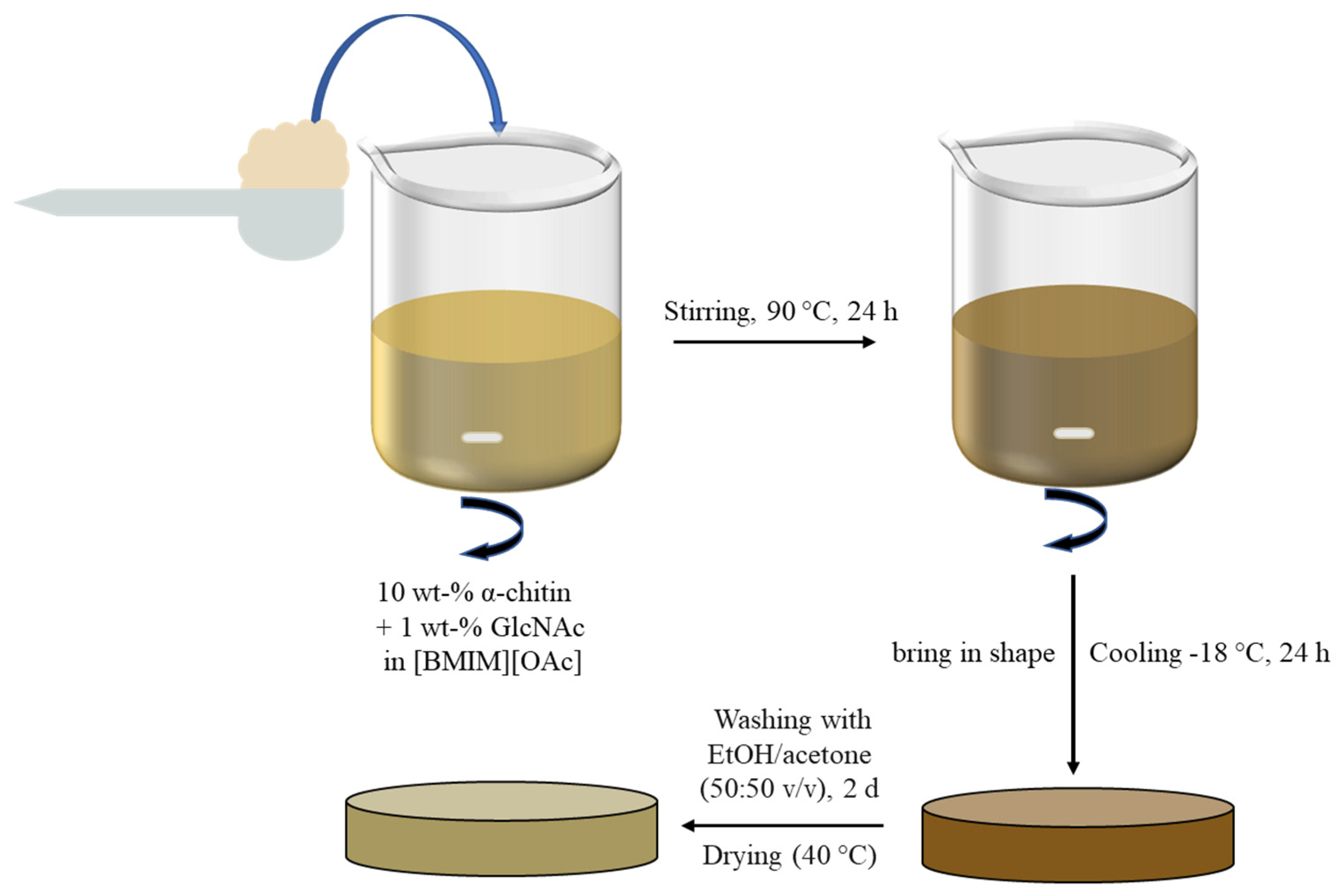
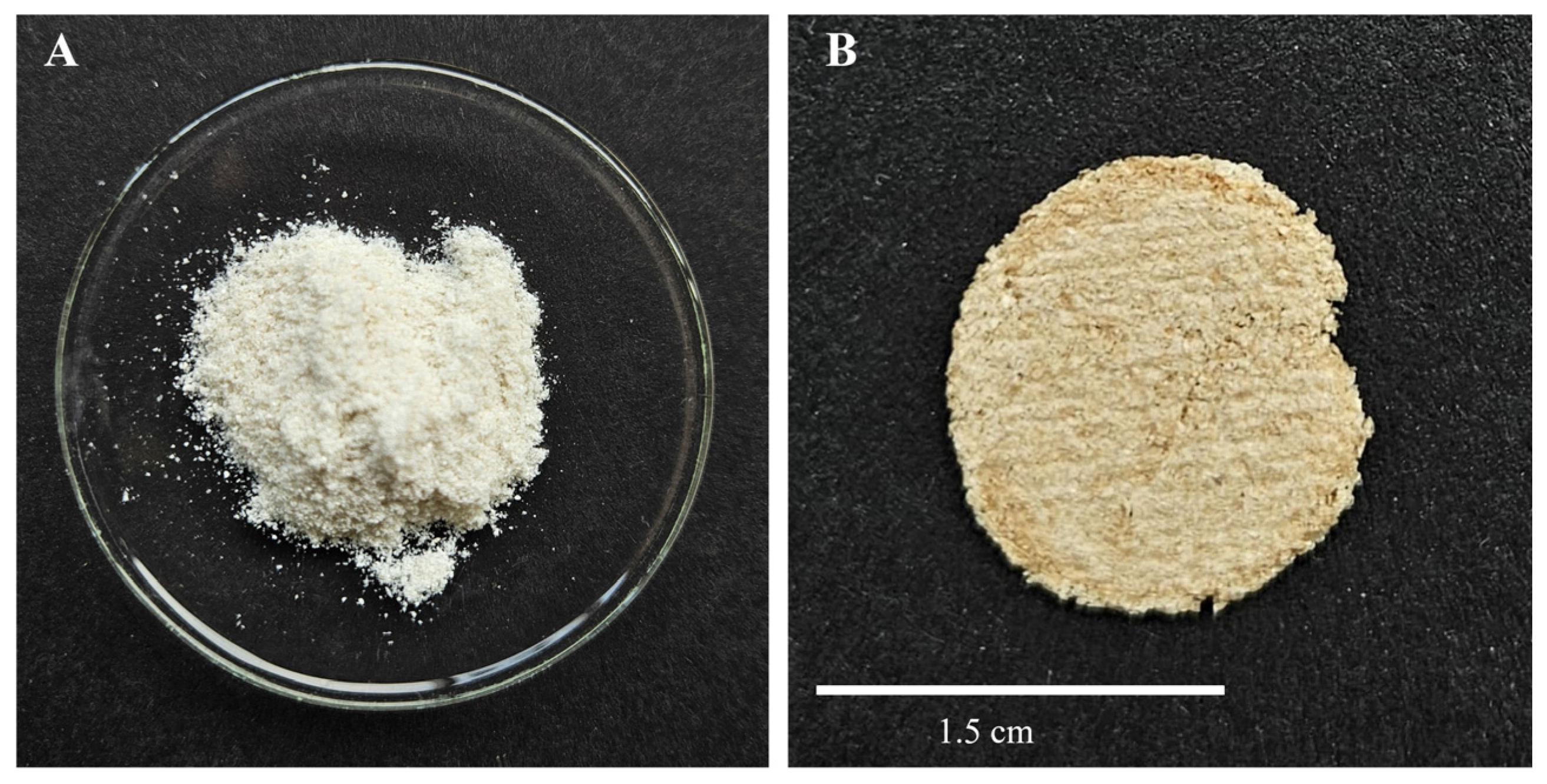
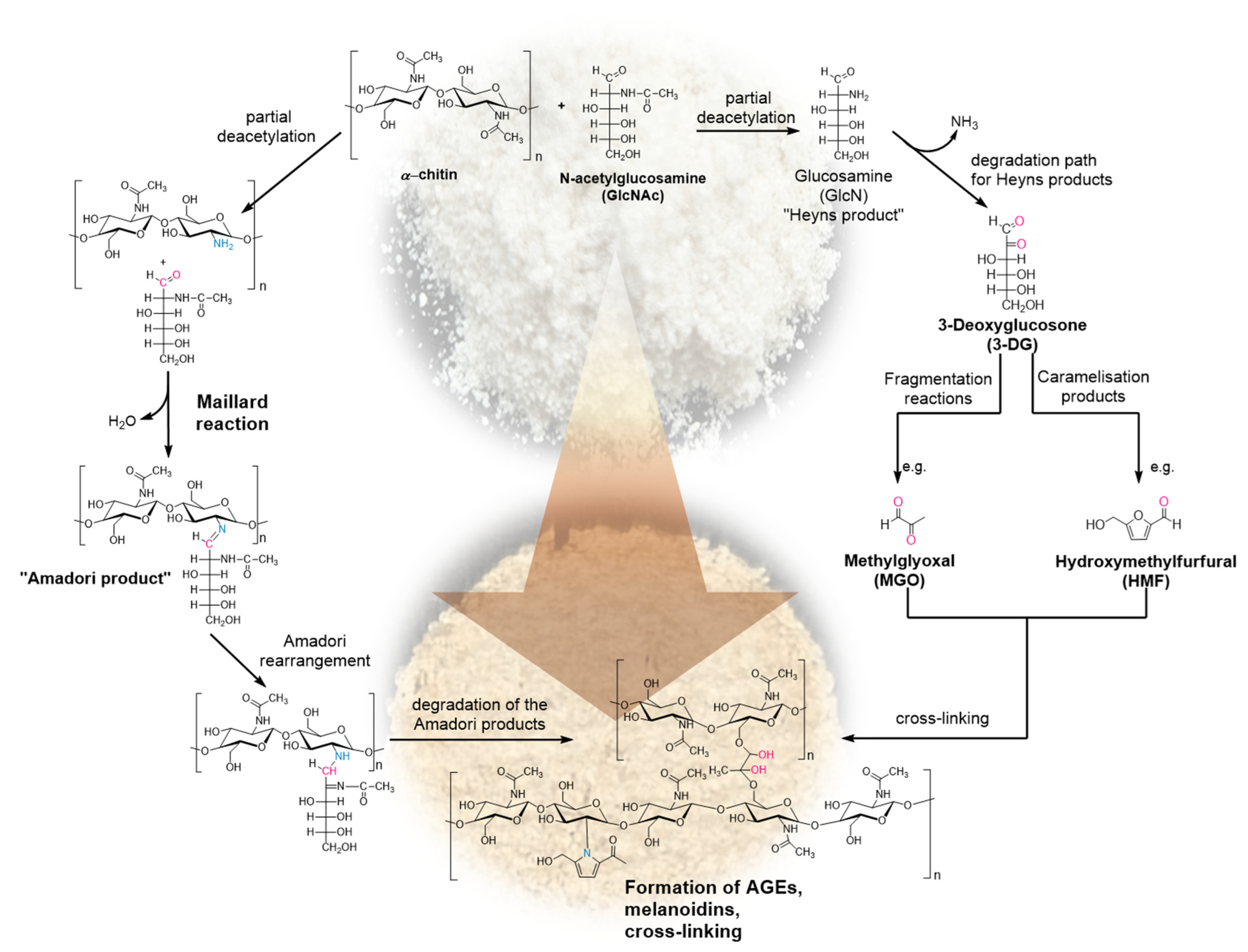

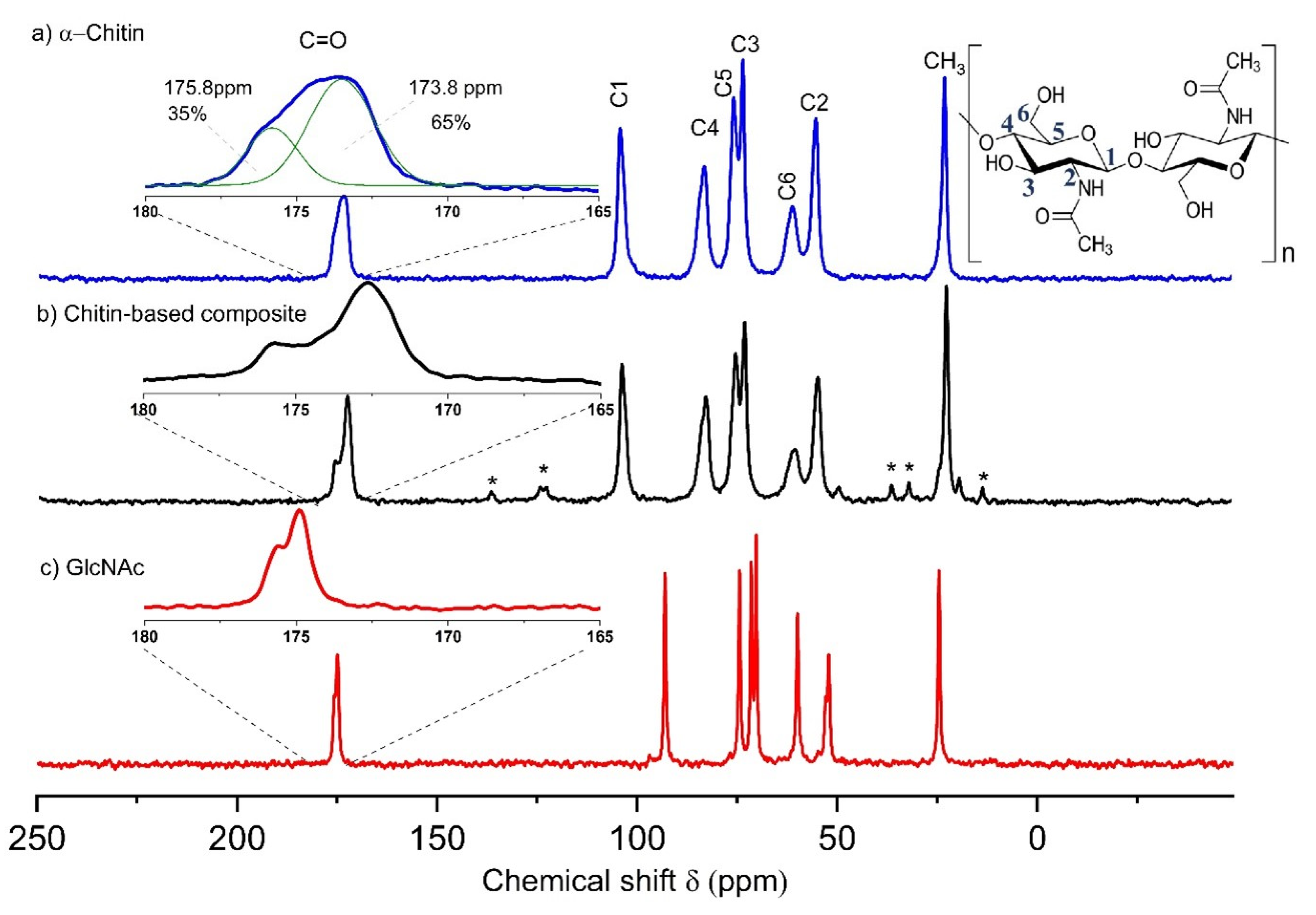
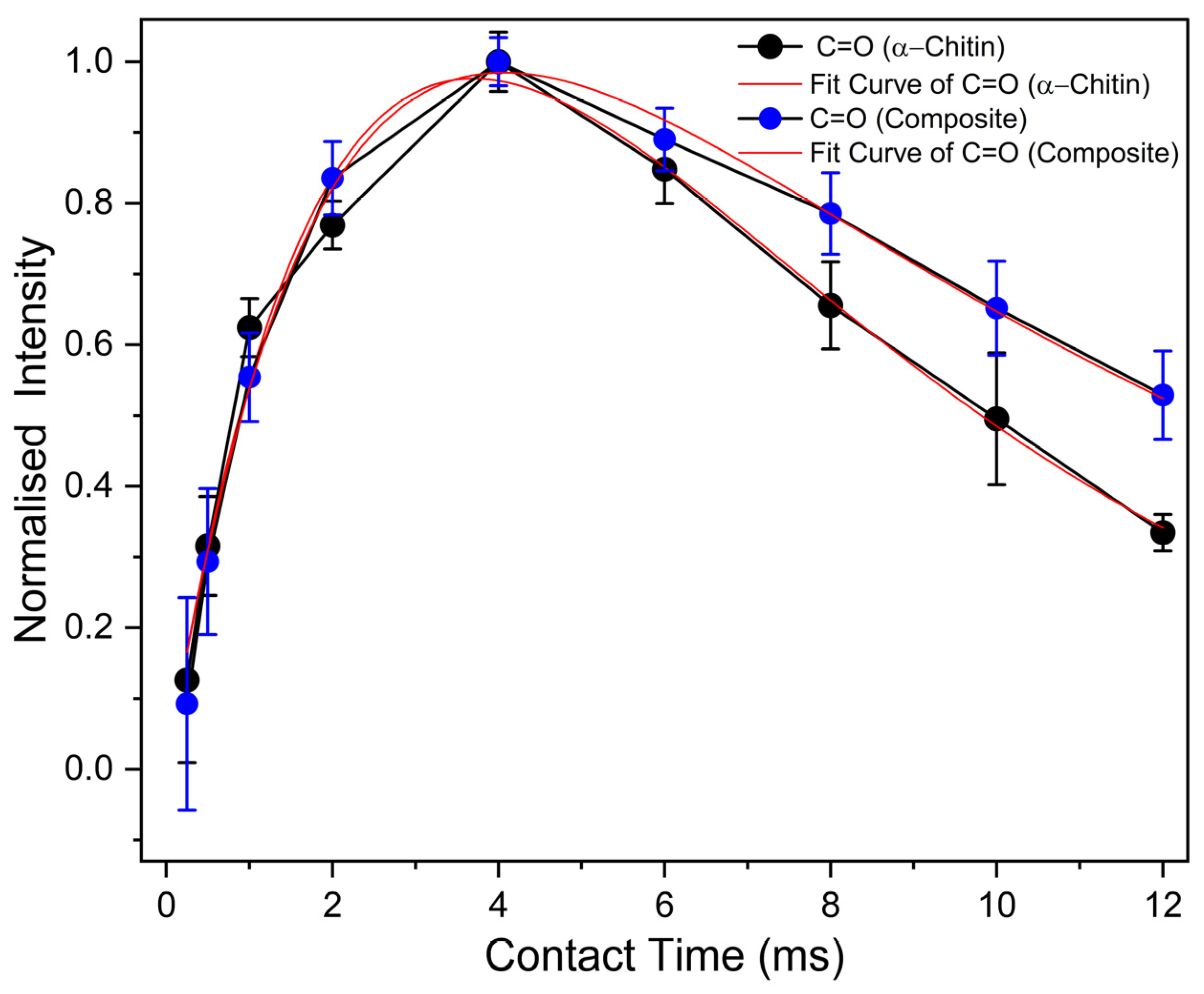

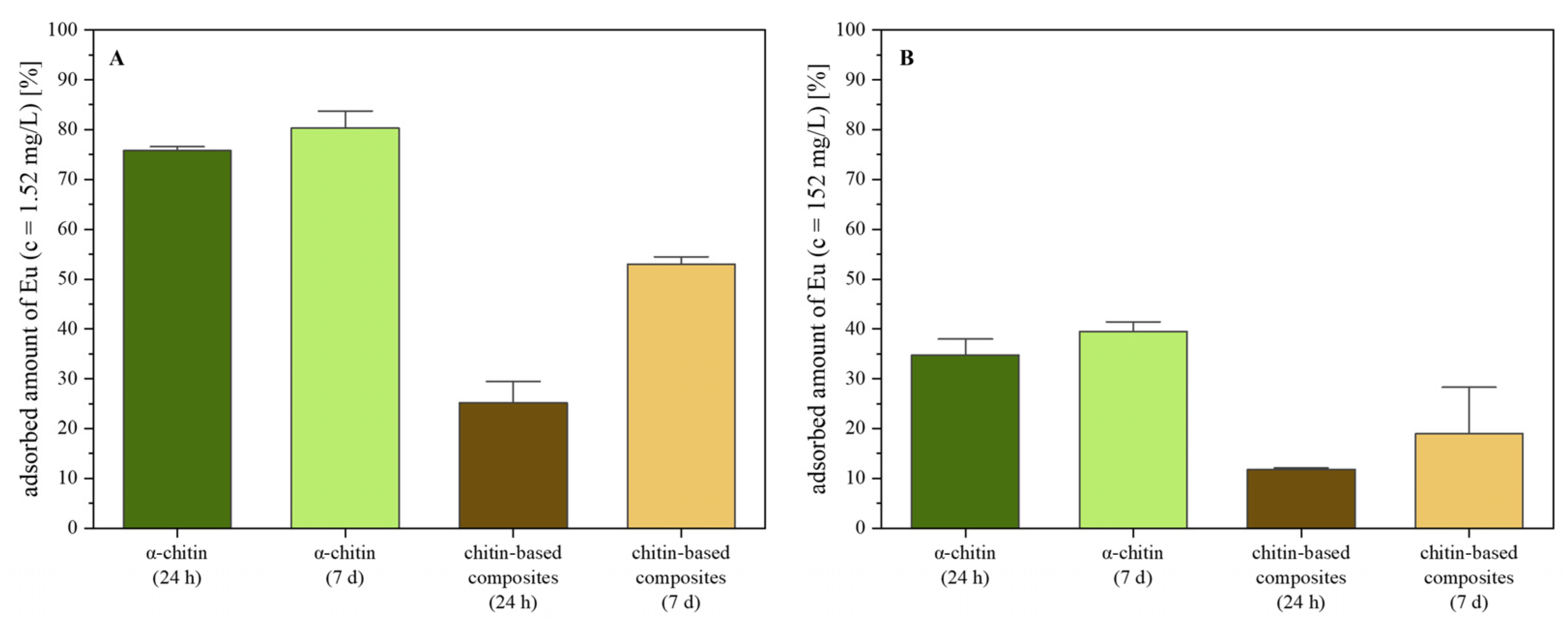
Disclaimer/Publisher’s Note: The statements, opinions and data contained in all publications are solely those of the individual author(s) and contributor(s) and not of MDPI and/or the editor(s). MDPI and/or the editor(s) disclaim responsibility for any injury to people or property resulting from any ideas, methods, instructions or products referred to in the content. |
© 2025 by the authors. Licensee MDPI, Basel, Switzerland. This article is an open access article distributed under the terms and conditions of the Creative Commons Attribution (CC BY) license (https://creativecommons.org/licenses/by/4.0/).
Share and Cite
Aravind, A.; Seliverstova, K.; Kammerlander, K.K.K.; Henle, T.; Brunner, E. Processing α-Chitin into Stable Composite Materials for Heavy Metal Adsorption. Int. J. Mol. Sci. 2025, 26, 3149. https://doi.org/10.3390/ijms26073149
Aravind A, Seliverstova K, Kammerlander KKK, Henle T, Brunner E. Processing α-Chitin into Stable Composite Materials for Heavy Metal Adsorption. International Journal of Molecular Sciences. 2025; 26(7):3149. https://doi.org/10.3390/ijms26073149
Chicago/Turabian StyleAravind, Anjana, Kristina Seliverstova, Kaitlin K. K. Kammerlander, Thomas Henle, and Eike Brunner. 2025. "Processing α-Chitin into Stable Composite Materials for Heavy Metal Adsorption" International Journal of Molecular Sciences 26, no. 7: 3149. https://doi.org/10.3390/ijms26073149
APA StyleAravind, A., Seliverstova, K., Kammerlander, K. K. K., Henle, T., & Brunner, E. (2025). Processing α-Chitin into Stable Composite Materials for Heavy Metal Adsorption. International Journal of Molecular Sciences, 26(7), 3149. https://doi.org/10.3390/ijms26073149







